Content
- 1 Do you need to cut the leaves?
- 2 Why fertilize withering plants?
- 3 Cutting leaves
- 4 When should you transplant daffodils?
- 5 When are tulip bulbs dug up?
- 6 When should you plant?
- 7 What to do if presented with a tulip in a pot?
- 8 What to do right after flowering?
- 9 How do you dig up and store the bulbs?
- 10 When and how to plant tulips?
- 11 Growing tulips outdoors
- 11.1 Choosing bulbs for planting
- 11.2 When should tulips be planted? Landing time and dates
- 11.3 Site selection and site preparation for tulips
- 11.4 Planting tulips
- 11.5 Tulip planting video
- 11.6 Tulip care rules
- 11.7 When to dig up tulips?
- 11.8 Video on digging and storing bulbs
- 11.9 Propagation of tulips
- 11.10 Mouse protection
How do you ensure that tulips are cared for after flowering so that the bulbs are stocked with nutrients for the next flowering? Maybe you need to cut off all the leaves at once? Or is it still worth continuing watering and feeding? You can find the right solution by learning a few rules for growing bulbs.
Do you need to cut the leaves?
Daffodils and tulips are often planted side by side in a flower bed to create a picturesque picture. However, their neighborhood has one caveat. It consists in the fact that faded buds and yellowed leaves quickly become unattractive. But take your time to rid your garden of unkempt stems. Caring for tulips after flowering should be continued for another 2-3 weeks. And so that dry leaves do not spoil the decorative look of the garden, just plant perennials between them. For example, phlox.
The foliage of plants is recommended to be preserved precisely because the sun's energy and useful microelements enter the bulb through it. They saturate the plant. Cutting off the still green leaves of tulips means stopping the bulb formation process. On faded specimens, it is better to immediately remove the seed capsule. So the bulb will be able to accumulate energy in itself and will not waste it on the ripening of the seeds.
Advice. In order not to lose the location of the tulips after the foliage dries, you can mark it with markers or flags.
Why fertilize withering plants?
Caring for tulips after flowering requires timely fertilization. The point is that the development process is still ongoing. And the appearance of flowers in the next spring will depend on how much the gardener is not too lazy to water and feed the withering flower bed with special fertilizers. You need to water the flower bed as needed for another two weeks after cutting the peduncles. You only need to fertilize the soil once. This will be enough. You can pick up the usual mineral fertilizers for bulbous. But the dosage should be reduced by half of the recommended dosage in order to prevent chemical burns of cells. A phosphorus-potassium mixture is also well suited. Fertilizers containing nitrogen or chlorine must not be used.
Cutting leaves
Care for daffodils, as close relatives, is required in late spring in the same way as caring for tulips after flowering. If all the gardener's actions at this time are lined up sequentially, then they will stand in the following order:
- flowers are cut to form bouquets or allowed to naturally wither;
- in the second case, the seed capsule is cut off after the petals fall;
- in the last days of spring, special fertilizers are applied to the soil, while not forgetting to water the garden;
- leaves are cut off only after drying;
- after the bed is mulched with peat or wood ash.
When should you transplant daffodils?
These flowers can live in one place for up to five years.Do not disturb them for an annual transplant, otherwise the plants may not bloom so abundantly. But if the stems begin to get crowded and have already grown quite a lot, then it's time to plant them.
For a transplant, you will need:
- garden shovel;
- gloves;
- disinfecting solution.
Daffodil bushes are planted right away; young roots should not be allowed to dry out. Pick a late afternoon in early August, when the midday heat has subsided, and get started.
What do we have to do?
1) To begin with, the bushes are carefully dug up.
2) Then they are divided into smaller ones and laid out for processing.
3) For prevention, plants can be sprayed with a weak solution of potassium permanganate or a suitable fungicide.
4) In a new place, the holes are prepared and daffodils are transplanted into them with maximum accuracy.
When are tulip bulbs dug up?
Unlike daffodils, tulip care after flowering is required annually. If you want large flowers to bloom in the spring, plan to dig out the bulbs annually. This is best done in the middle of summer, when the leaves are completely dry. Try to dig one and see how it looks. If it is covered with brown scales, the roots have formed, the stems have practically dried up, then it's time to dig up the entire flower bed.
Caring for tulips after flowering in the garden is pretty simple. You just need:
- carton boxes;
- leaflets with inscriptions of varieties;
- garden shovel;
- gloves.
What do we have to do?
- choose a not too cloudy day in early July;
- prepare the necessary inventory;
- carefully dig up the plants, treat them with a disinfecting solution and arrange them by variety in cardboard boxes;
- discard all weak and small bulbs.
Thus, the summer care of tulips after flowering in the garden can be considered complete. Plants will be dormant for one and a half to two months before planting.
When should you plant?
If you are planning the usual planting of flowers that will bloom in April-May, then a fine day in early September is suitable. Take all boxes of bulbs to the air, carefully review all material. If there are spoiled copies, they must be removed immediately. If you find diseased material, then it will not be superfluous to re-treat with a fungicide.
Find a new place to plant flowers. Proper care of tulips and daffodils after flowering involves a constant change in the location of the flower bed. This way you can avoid depleting the soil.
Planting material in the pits. Loosen the soil and make indentations about half a spade in it. Spread the bulbs evenly and pour warm water over them. After two weeks, the garden can be fertilized with saltpeter. And with the onset of the first frost, its surface is covered with a layer of mulch (dry leaves, straw or peat).
Landing in trenches. The place chosen for the flower garden is laid out and trenches are dug. Their depth should not exceed 20 cm, and their width - 25 cm. Before placing on the bottom of the bulb, sprinkle it with saltpeter. Next, the largest specimens are distributed and crushed with earth. Smaller ones are spread over them and sprinkled again. If you are planning to disembark children, then it is best to distribute them along the edges of the trench. Further, it is covered to the top with soil. After planting, the ridges are watered. Such post-flowering tulip care at home will certainly give good results.
What to do if presented with a tulip in a pot?
It is very pleasant to receive the symbol of spring in a pot at the end of winter. But what to do with the plant after wilting? Throw it away? Do not hurry. Timely caring for tulips after flowering in a pot will give the plant another chance. For this:
- water the flower all the time until it turns yellow completely;
- let the stems dry;
- when the bulb goes into a dormant period, it can be dug up;
- dry it and store it in a box until September;
- and in the fall, plant on the ridges along with the rest of the bulbs.
Flowers love care and appreciate attention. If you did everything right and were worried about them from early spring to late autumn, they will definitely dissolve their delicate petals towards the sun. And they will delight you with their beauty.
Tulips belong to the group of ephemeroid plants. The development cycle of a group is different from that of other plants. Ephemeroids have a special agricultural technique that you need to know at least in general terms so as not to make gross mistakes when growing flowers.
Planting tulips
In nature, the development of tulips is confined to the short spring period. In summer, the plant rests, hiding in the ground in the form of a bulb. With the onset of autumn, the bulbs grow roots and form the rudiments of leaves and flower shoots. In early spring, when the soil warms up slightly, rapid growth and flowering begins, and by the beginning of summer the plant ends its growing season and disappears from the soil surface.
Tulips are planted in autumn, at the same time as winter garlic. Landing depends on the weather. There is no need to rush, the soil for autumn planting must cool at least 15 ° C. But you can't hesitate, since the bulbs in the soil must have time to take root and prepare for wintering. Small bulbs are planted first in the ground so that they do not dry out. Plant large ones later, when the ground cools down to + 10 ° С.
The approximate dates for planting tulips are September and October. The exact timing depends on the climate and weather conditions. In the northern regions, in some cold years, the bulbs can be planted in early September. In southern climates, planting is shifted to October.
Good flowers come from adult bulbs - healthy, heavy, well-done, with a healthy and shiny, tight-fitting integumentary scales. Small baby bulbs will give small flowers on short peduncles or will not bloom at all next year.
Any area where water does not stagnate is suitable for tulips. The plant can grow and bloom even in partial shade, near a fence and under a tree. But in such conditions, flowering will come a week or two later and will last a little longer, and the peduncles will be curved. Therefore, plants intended for cutting are planted in places open on all sides.
The best predecessor of tulips will be black fallow, a perennial ornamental crop. These flowers cannot be planted after onions, garlic, potatoes, peppers and eggplant - these plants are affected by common diseases and pests.
Planting bulbs begins with soil preparation. The earth is dug up with a lot of organic matter, peat or compost. After digging, the organic matter should be evenly distributed in the soil. It is not necessary to add humus to the planting hole, as this will burn the roots and the plant will get sick all season.
The compost must be completely decomposed. Half-matured plant residues will give rise to outbreaks of fungal and bacterial soil diseases. A little fluff lime is added to the acidic soil.
Tulips love wood ash. This substance alkalizes the soil no worse than fluff and enriches it with a valuable mineral complex. Ash is scattered over the surface of the soil before digging in an even layer 5-10 mm thick.
Before planting, the bulbs are kept in a pink solution of potassium permanganate for two hours and immediately planted in the soil without drying. If there is no time to disinfect the bulbs, you can spill manganese into each well.
The depth of planting tulips outdoors depends on the size and type of soil. In general, the more sand in the soil and the smaller the bulb, the finer the planting should be. The largest bulbs are planted to a depth of 18 cm, the baby - 8-10 cm. Usually gardeners are afraid to plant tulips deeper, preferring a shallow planting. But shallow plants fade quickly, and the bulbs degenerate after 2 years.
In October, when the topsoil freezes over, the plantings of tulip flowers are sprinkled with peat or fallen leaves.If no organic matter was introduced during planting, then now is the time to mulch the soil with last year's humus.
The mulch evens out the temperature in the upper layers of the soil, which helps the bulbs to cope with the winter cold more easily. In the spring, as soon as the snow melts, urea is scattered over the surface of the mulch at the rate of a tablespoon per meter of planting and slightly loosened the mulch with a rake so that the fertilizer balls roll deeper into organic residues.
Growing tulips
Outdoor care consists of:
- watering;
- dressing.
After cutting the first leaf, the planting is fed with urea, if this was not done immediately after the melt water disappeared. During flowering, plants need phosphorus and potassium. It is better to make foliar dressing before flowering with any fertilizer suitable for the composition for flower crops (Kemira flower). In addition to phosphorus and potassium, the composition of the fertilizer should include iron, magnesium, zinc, calcium and manganese - without these elements, the petals become pale, the flower stalks lodge.
It is important to provide sufficient calcium and magnesium for the forcing bulbs in winter. Without these chemical elements in plants during their cultivation in a greenhouse, yellowing of the leaf tissue between the veins will begin - interveinal chlorosis.
How to know if there is enough calcium in the soil - the soil with a high content of this element has a granular structure. If you take a handful of such earth in your palm, you will notice that it all consists of small lumps. This is the best soil structure possible.
To eliminate the calcium deficiency, the plants that are planned to be used for forcing are fed with calcium nitrate, making a 1% solution from it for foliar feeding. Top dressing is carried out at least 2 times, and preferably 3 times, evenly distributing them from the phase of unfolding the first two leaves to the budding phase.
When growing tulips in the open field, watering is required, since the plants have a short and weakly branched root system. The amount of irrigation depends on the weather.
The first critical phase is budding. If during this period the plant is thirsty, then the blossoming flowers will be small.
Flowering is the second critical period. 1-2 waterings done during flowering will increase its duration. After flowering, the plants are watered 3 times.
Landings are periodically inspected. All plants affected by the variegation virus are removed with the bulb using a manual bulb planter.
Signs of viral diseases:
- severe growth retardation;
- rolling leaves;
- spots and strokes on the petals;
- uneven color of the leaves.
Caring for tulips after flowering
The bulbs are dug up when the leaves turn yellow and begin to dry out. You should not wait for the leaves to die completely. Overexposure of the bulbs in the soil leads to infection with fungal diseases, since the integumentary scales, by the time of the final ripening of the bulb, lose their immunity and even themselves can become a spread of infection.
When digging at the correct time, the nests do not have time to disintegrate, and the integumentary scales adhere tightly to the bulb. Such planting material is well stored until planting.
Bulb care
Planting material is stored until autumn planting in plastic mesh containers. The bottom of the container should also be mesh. Good aeration helps keep the bulbs dry and prevents bacterial infections, onion mites and mold. After digging, the container with the bulbs is left for several hours in the fresh air in the shade, then removed to the barn.
If the bulbs have a lot of spots and foci of rot, then you can soak them for half an hour in a pink solution of manganese, then dry in the shade and put away for storage. Double soaking in potassium permanganate - before planting and after harvesting - not only prevents outbreaks of fungal diseases, but also meets the needs of plants for manganese.
You can use disinfecting solutions only in the first days after digging. The stored bulbs are inspected from time to time. If, during storage of the planting material, it is found that spots or mold have appeared on it, dusting should be used, taking dry ash or foundation powder for this.
Gardening Tips
If you happen to be the owner of tulip bulbs not in autumn, but in early spring, then you need to try to keep them in a cool place until autumn. Place the bulbs under a canopy in your country house, pouring them into a wire mesh container, and then plant them at the usual time for tulips. Bulbs planted in spring will not take root, they will most likely simply rot in the summer in the ground.
Tulips are unpretentious and can grow in a variety of soils, putting up with poor maintenance. However, in this case, there is no need to hope for the maximum decorative effect - the plants will be inconspicuous, stunted, with faded and small flowers. In the absence of care, flowering continues for several days, but if you take care of the plants, the flower will delight the eye for up to 2 weeks. Therefore, when growing, it is worth observing at least the minimum rules of agricultural technology.
If the tulips on the site quickly become smaller and degenerate, then the reason should be sought in the soil. Most likely, it lacks nutrients. When planting, add a bucket of organic matter for each meter of planting and the situation will return to normal.
Plants love neutral and slightly alkaline soil. Sometimes it is enough to add half a teaspoon of fluff to each hole when planting, and tulips begin to grow where they previously refused, due to the fact that they were damaged by wireworm or the variegated virus.
You cannot plant tulips next to gladioli - they are affected by common diseases.
Before planting tulips, you need to decide whether you have to dig them out every year or every few years, since the planting scheme depends on this. In the latter case, a distance of at least 25 cm is left between the plants.
If it is supposed to dig up the bulbs annually, then it is most convenient to plant annual seedlings in the place vacated at the beginning of summer. When the summer plants finish their growing season in the fall, bulbs are planted again in their place. This technique allows you to get an impressive-looking carpet of densely planted tulips in spring.
Lovers of perennial ornamental plants can use tulips as a sealant. In such plantings, the bulbs do not have to be dug up annually. They are planted in the fall in several pieces, placing them between perennials in free places. The leaves that turned yellow by the end of spring will be hidden under the perennials that have grown by that time. For such a neighborhood, perennial plants are suitable, in which foliage grows slowly: hosts, astilbe, paniculate phlox.
When planting bulbs, you need to avoid their single location, straight lines and regular geometric shapes. The peculiarity of tulips is that they look best in groups with irregularly defined edges. In such plantings, large bulbs are placed in the center or in the background, since they will grow the tallest plants.
When creating a flower garden, it should be borne in mind that flowers go well with low-growing plants. The traditional companion is pansies - viola. When grown through seedlings or in a two-year culture, the viola blooms at the same time as the tulips, and later, left alone, blooms most of the summer. Groups of tulips look spectacular against the background of a solid carpet of viols.
The peculiarities of growing tulips allow you to receive flowerpots and containers for loggias and balconies beautifully decorated with flowers in early spring. Planting times will be the same as in the garden - the bulbs are planted in the fall in a container and, with the onset of frost, are brought into a cool dark room - a cellar or underground. The earth in the container is occasionally moistened. In early spring, at the first shoots, the containers are transferred to a permanent place.
Now, knowing the secrets of growing, you can use these plants to decorate your plot and balcony, or grow a beautiful cut for making bouquets.
The tulip is an early flower, it is one of the first to please us with bright colors on a flower bed. Inexperienced growers often do not know what to do with these flowers after they have faded. Do tulips need care after flowering? Yes, it is required, unless of course the florist wants to get beautiful flowers next season, you need to continue caring for the plants after flowering. With proper care, you can get not only great flowers next season, but also extra baby bulbs.
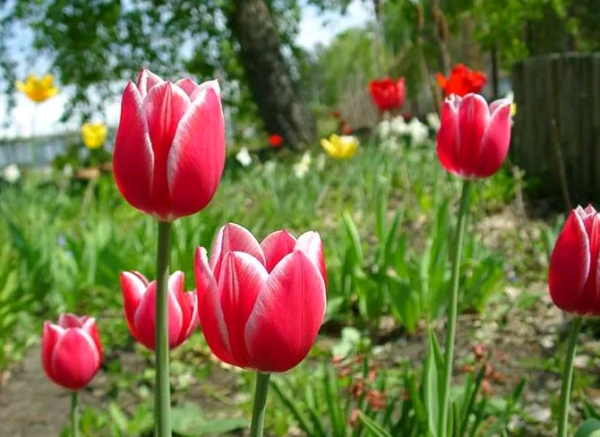
What to do right after flowering?
Tulips have faded, what should I do next? You should not cut off the leaves of flowers immediately after they have faded, if the bulb of the flower stops developing. In order for the bulb to develop well, you need:
- When the tulips bloom, you must immediately remove the peduncle so that the plant does not waste nutrients for the development of seeds in the seed box;
- Within 2 - 3 weeks they are watered and fertilized with a complex mineral fertilizer containing potassium and magnesium, one feeding is enough;
- The plant is pruned after all the leaves turn yellow and dry.

Important! When watering tulips, try to moisten the soil to a depth of at least 40 cm. The roots of the flower are not able to extract moisture from the lower layers of the soil, so they need to be deeply watered.
How do you dig up and store the bulbs?
Some growers believe that you can dig up flowers once every 2 - 3 years, this is not correct, staying in the ground, the bulbs are exposed to various infections and this has a bad effect on the quality of the seed. Digging tulips annually in temperate regions is a must-have in post-flowering tulip care.
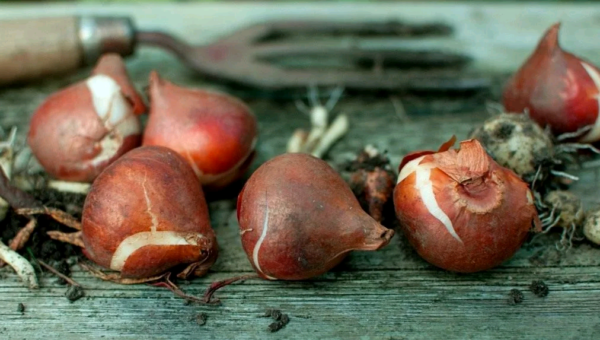
Around the end of June or early July, after pruning the tulips, the bulbs are dug up:
- It is necessary to dig up the bulbs in dry sunny weather, then they will dry out faster;
- When digging, stick the shovel to the maximum depth so as not to damage the bulb;
- After you dig up all the bulbs, carefully review them and if you get sick, immediately dispose of them;
- There is no need to dig up tulips all in a row, first the early varieties are removed, then the later ones;
- Soak the onions in a 5% solution of potassium permanganate for several minutes, then dry.
Excavated bulbs should have brown scales and well-formed roots. Tulips are folded in boxes with a bottom made of mesh material, for better air access, in two layers and stored in a dark, well-ventilated, dry place. In the first month, the storage temperature should be 23 - 25 ° C, then the storage temperature should be reduced to + 20C °, and a week before the flowers are planted on the flower bed, the storage temperature should not be higher than + 17 ° C.
When storing, avoid sudden changes in temperature, otherwise you can get “blind” buds instead of beautiful flowers.
When and how to plant tulips?
You can plant tulips in the ground already in September, look at the weather, if the constant air temperature is in the range of 5 - 7 ° C, then you need to plant.

This requires:
- The prepared seed is again treated with a 5% solution of potassium permanganate;
- Choose a new planting site, you cannot plant flowers in the same place where they grew before. The landing area should be well lit and windless;
- Dig a furrow 15 cm deep for large bulbs and about 6 - 7 cm for children, if you plan to plant several rows, the distance between them should be at least 30 cm;
- Add sand and wood ash to each furrow, the soil becomes loose from this, and ash is also an excellent fertilizer. Never use fresh manure as fertilizer for tulips, the bulb of the plant can get burned and die;
- Choose the same size bulbs for planting in one row, because the smaller the bulb, the smaller the groove it needs, also keep in mind that the babies will not bloom in the first year after planting;
- The distance between the bulbs in the furrow should be 10-15 cm, the larger the bulbs, the greater the distance between them should be;
- Before planting flowers, the grooves must be shed with water. The planted plants are also watered, then the earth envelops the bulbs better, and they take root better.
When planting tulips, it is better not to pull too much, they should have time to take root before frost, if this does not happen, the plants may simply die.
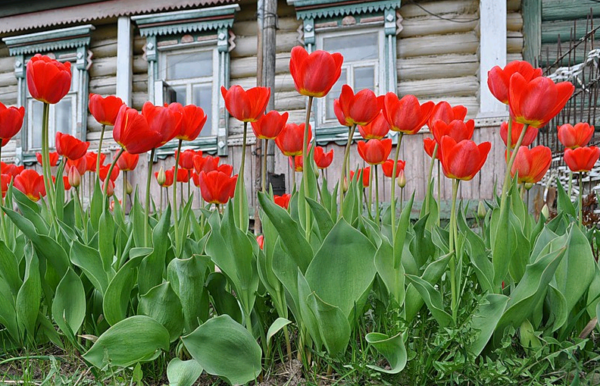
If the autumn is abnormally dry, then 2 weeks after planting, the flowers must be watered again.
When the weather is already with a steady minus and the ground is frozen by a few centimeters, the flowers need to be covered, dry foliage, sawdust, and straw are suitable for this. If covered before frost sets in, tulips can start growing.
If the winter is not very snowy and the snow layer on the flower bed is thin, you can shovel snow from another territory and pour a thicker layer of snow onto the flower bed, then the tulips will definitely survive the winter without loss.
Tulips are very popular flowers, today we'll talk about planting and caring for them outdoors. They have won the hearts of many people with their beauty. Modest flowers adorn not only personal plots, but also city flower beds. The fashion for tulips came to us from Holland. Gorgeous flowers never cease to delight with their beauty and rich palette of colors for many years. They started growing tulips in Persia. Then they learned about their existence in Turkey and Europe. The name of the flower comes from the oriental headdress "turban". In Turkey, this graceful flower is usually worn in a turban.
The tulip is a member of the Liliaceae family. There are many garden varieties of these beautiful flowers. The height of the plant depends on the variety. The size of miniature species does not exceed 20 cm.Tulips with a height of 70 cm are found.
Bell-shaped flowers have different colors. Tulip petals are both simple and double. And now more about
Growing tulips outdoors
Choosing bulbs for planting
It is advisable to buy tulip bulbs before the start of the planting season. The most suitable time for this is late July - mid September, when they are at rest. It will be very difficult to acquire quality planting material during the planting season. In the spring, as a rule, they sell old bulbs that did not have time to sell last season.
Preference should be given to bulbs with a thin golden skin. Cracks on them shouldn't scare you. The main thing is that the bulb itself is not damaged, since the planting material is easily injured. 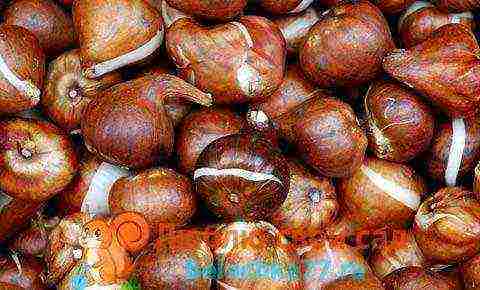
A thick, dense bulb with dark brown scales indicates that it is not suitable for planting, it will be very difficult for the roots to germinate.
If it is not possible to immediately plant flowers, tulip bulbs are removed in a cool room. They are kept separate from other bulbs. If diseased bulbs are found, they will infect healthy ones.
In terms of size, it is best to use young, healthy, medium-sized bulbs. They should look good. On an unsuitable for planting bulb, there will be mechanical damage, mold spots, dried pulp.
The surface of the bulb must be firm and clean. It will not be superfluous to take the onion in your hand. Low weight indicates illness. A healthy bulb feels heavy to the touch.
When buying, you need to inspect the bottom of the bulb. On quality bulbs, root tubercles are visible. You should not buy planting material with a soft bottom, rotten or sprouted roots.
When should tulips be planted? Landing time and dates
Central Asia is the homeland of almost all varieties of tulips. In their natural environment, they grow in steppes, deserts, foothills, in mountainous arid regions. In early spring, they form bright flowering carpets.With the onset of heat, beautiful tulips fade. But the bulbs continue to exist, going deeper into the ground. In the fall, new roots appear on them. In the spring, awakening from winter sleep, tulips bloom again, delighting us with their beauty. 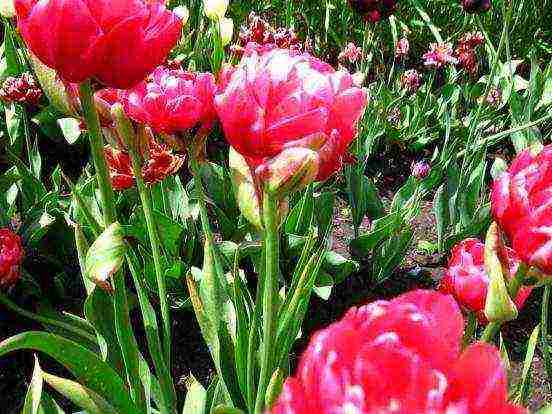
In nature, tulips bloom only after winter cooling. During this time, they accumulate special nutrients that help them germinate.
Planting tulips in autumn
Experienced flower growers plant tulips only in autumn. Planting time depends on the region where the flowers are grown and the climatic conditions.
In the middle lane, tulips are best planted at the end of September.
In the southern regions, they have been doing this since the beginning of October, when the thermometer readings drop to 7-10 ° C. The root system of the bulbs is formed in 3-4 weeks. It should be borne in mind that the weather can make its own adjustments.
With early planting, the rooting process is delayed, the bulbs can get sick with fusarium. In addition, in warm weather, the garden bed can become overgrown with weeds, which will take away the strength from the tulips.
Planting flowers too late is also not recommended. Due to frost, the root system may not form. They can rot or freeze. Usually, these tulips do not bloom well, their bulbs are not suitable for further planting. 
If the bulbs are planted in November, they are covered with spruce branches or foliage for the winter.
If the recommended planting dates are missed, it is better to plant tulips before the beginning of December, covering the flower beds with straw or dry leaves. Flowers planted in spring will lag behind in development.
Read more about planting in the article "How to plant tulips in the fall"
Planting tulips in spring
Spring is an unfavorable time for planting tulips. Flowers, of course, will grow, but they will bloom later. To speed up flowering, the bulbs are placed in the refrigerator overnight before planting.
After cooling, they are washed with a weak solution of potassium permanganate and planted in open ground. This must be done by April. If there are still frosts in your area at this time, the bulbs are first planted in containers, and then carefully transplanted into a flower bed.
Site selection and site preparation for tulips
- Tulips will be most comfortable in a well-lit place.
- Graceful flowers cannot stand drafts, so they must be protected from strong winds.
- They are suitable for areas with a flat surface that are protected from groundwater.
- For normal growth and development, flowers need a thick, fertile layer of soil.
- They like loose soils with neutral to moderate acidity.
When choosing a place for planting, it is worth considering which plant was grown here before. Vegetables and flowers are considered good predecessors. In order to avoid infection with viral diseases, they cannot be planted in the place of nightshades and bulbs. 
Tulip growth is highly dependent on the choice of soil. It should be loose, fertile, moisture and air permeable. Loamy soils and sandy loams, rich in humus, are most suitable for them. Other soils can be enriched by applying certain fertilizers.
Sandy lands dry up quickly and contain few nutrients. To eliminate these disadvantages, tulips will have to be watered more often and fed with mineral fertilizers.
It will be more difficult with heavy clay soils. In order for them to become suitable for tulips, coarse river sand, peat, rotted manure are introduced into them. This will help increase the permeability of the soil. When using peat, its increased acidity is neutralized with chalk or lime. During the period of intensive growth, heavy soils should be loosened more often.
In the spring, at the place of future planting of tulips, slowly decomposing organic fertilizers should be applied to the soil. Rotted manure or compost works well.
Planting tulips
Only healthy and high quality bulbs are suitable for growing. Before planting, all bulbs must be carefully inspected in order to identify contaminated material in time.
If you are going to plant bulbs that you have grown on your own, they must be etched in a 0.5% solution of potassium permanganate within 30 minutes. Planting material purchased from a specialized store or garden center is fully prepared for planting.
For planting tulips, it is necessary to prepare beds 1-1.2 meters wide with longitudinal or transverse furrows. The length of the ridge can be of any size. 
The prepared bulbs are carefully pressed into the bottom of the furrow so as not to damage the root system, they are covered with earth.
Planting depth depends on bulb size and soil type.
On light soils, tulips are planted deeper than on heavy ones. A distance of 20 cm is kept between the rows.The bulbs are planted every 9-10 cm.
Many growers plant tulips with a tube. To do this, take a metal tube 5 cm in diameter with a piston that can be fixed. Having chosen a column of earth of the required depth, an onion is lowered into the hole, and the earth is pushed out with a piston. This method has many advantages. Correctly planted bulbs will be protected from damage and hands will not freeze.
Plastic baskets are also used to plant tulips. This method is simple. The bulbs are carefully laid out along the bottom of the basket, the container is placed in the prepared recess and sprinkled with earth. Flower bulbs will not be lost in the soil. They can be dug up at any time. 
When tulips are mass-planted, a 10-15 cm thick layer of soil is removed in a prepared area, the bulbs are laid out and sprinkled with earth. With this planting method, you can make a floral pattern using tulips of different colors.
Tulip planting video
Tulip care rules
Despite the fact that tulips are unpretentious plants that are resistant to various diseases, improper care of these modest flowers can lead to rotting of the bulbs, deformation of the stem and the appearance of blind buds.
Well-prepared soil makes it much easier to care for flowers.
As a rule, tulips come out from under the snow in late March - early April. If you covered the flowers for the winter, the mulch is removed immediately when the snow melts. The earth will warm up faster, and tulips will bloom earlier.
When the first sprouts of flowers appear, they must be carefully examined in order to identify defective and diseased bulbs. To prevent the disease from spreading to healthy tulips, bad bulbs are dug up and destroyed. 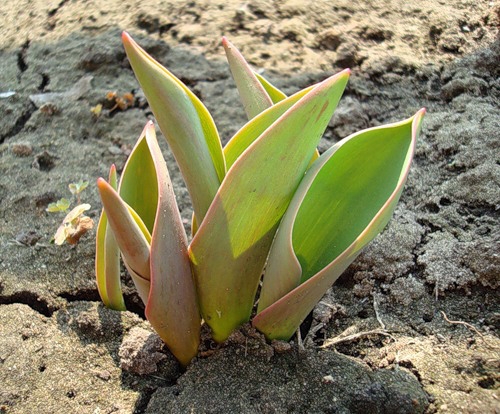
To increase the access of oxygen to the roots, the soil around the sprouts must be carefully loosened. This procedure is carried out throughout the entire period of intensive tulip growth. It is especially important to loosen the soil after watering.
Tulips need moderate watering before flowering. Overdrying of the top layer of the earth should be avoided.
Fertilizing tulips:
- When the sprouts appear from the ground, they must be fed with nitrogenous fertilizers so that the foliage will grow.
- The second feeding is carried out when several tulip sheets have unfolded. This time you need to use complex mineral fertilizers.
- During the period of bud formation, flowers really need phosphorus and potassium.
- The last time complex mineral fertilizers are applied when the buds bloom.
During feeding, precautions should be taken so that the flowers do not get burned. Fertilizers are applied in cloudy weather or during watering.
During flowering, watering tulips should be abundant, watered them only with warm water. In order for them to develop well, they should be fed with phosphorus-potassium fertilizers. Manganese, zinc and boron contribute to the development of bulbs.
During flowering, tulips are also examined, digging up diseased specimens. 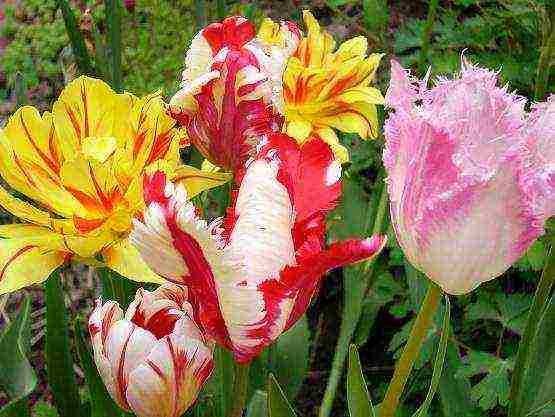
The tulip bloom ends very quickly. After wilting, the flowers are watered for another 2-3 weeks. Inflorescences that have faded must be pinched off so that the plant does not waste energy on the formation of seeds.
When to dig up tulips?
Common red varieties usually grow in one place for several years without digging up and replanting. But varietal tulips, in order to preserve their decorative effect, need to be dug up. Otherwise, they will go deeper into the ground, and the flowers will become smaller.
At the end of mid-June, when the leaves wilt by half and become soft, you can start digging.
After removing from the ground, the bulbs are cleaned and dried in the shade. Then they are placed in boxes or boxes in a thin layer and left until autumn in a room with a temperature of about 20 ° C. It must be well ventilated.
It is necessary to sort out and check the bulbs during storage - remove sick and rotten ones immediately.
Video on digging and storing bulbs
Propagation of tulips
Tulips can be propagated by seeds and babies.
The seed method is very long - it is a job for professionals and for breeding new varieties. Seeds are sown in boxes and grown for 3 years in one place, then planted on a separate bed for growing. And they have been growing for several years. The first flowering can be 5-6 years after sowing. And they become truly decorative after 10 years.
And at the same time the varietal characteristics of the parents are not inherited. So tulips are cross-pollinated flowers.
It is easier and faster to grow tulips from babies. Moreover, children retain the varietal characteristics of the parent onion.
For small onions to form sooner, you need to cut the flower during flowering. Then, at the usual time, we dig out the onion, after the leaves have wilted.
Small onions are separated and planted in a separate bed in the fall. They cover for the winter. They are grown for two to three years, flowers are plucked out. Let it grow a good, full-bodied bulb before flowering.
Every summer, they are dug up, like the adult flowering bulbs.
Mouse protection
Mice are very fond of feeding on bulbs left in the ground. To protect the flowers from rodents, daffodils and hazel grouses must be planted on the site next to the tulips. The bulbs of these plants are poisonous to mice. Also, pests cannot stand cinoglossum beds.
You can take care of the safety of the bulbs in advance by carefully treating them from a spray bottle before planting with kerosene or Vishnevsky ointment. Mice are also deterred by the smell of red ground pepper. In the fight against rodents, you can use granular poison. It is buried next to beautiful tulips.
Plant tulips with pleasure in your plots - planting and caring for them will not bother you now!
Best regards, Sophia Guseva.
Other helpful articles:
- Irises - planting and care
- Peonies - growing, planting, care, reproduction
- Hyacinths - growing and care
- Daffodils - planting and care


